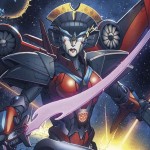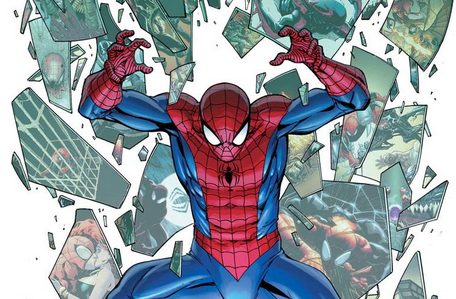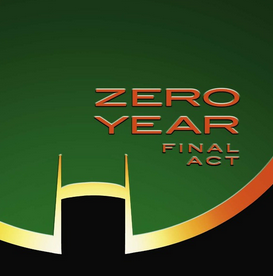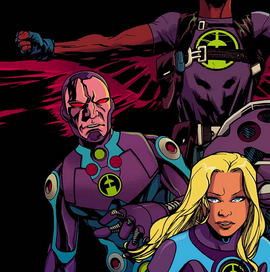Deadshirt Is Reading… is a weekly feature in which Deadshirt’s staff, contributing writers and friends-of-the-site offer their thoughts on a diverse array of comics, from name-brand cape titles to creator-owned books to webcomics.
Joe Stando is reading…
In honor of this week’s Superior Spider-Man #31, Deadshirt contributor Joe Stando gives us a rundown of the pros and cons of Dan Slott’s controversial fifteen month storyline.
Superior Spider-Man #31
Written by Dan Slott and Christos Gage
Art by Giuseppe Camuncoli (pencils) John Dell & Terry Pallot (inks) Antonio Fabela (colors) Will Sliney (pencils and inks, backup story) and Edgar Delgado (colors, backup story)
Lettered by Chris Eliopoulos
Marvel
“Because I’m Spider-Man. And when I’m around, no one dies.”
Superior Spider-Man has come to an end, and what and end it was. I didn’t expect the premise (the villainous Otto Octavius hijacking Spider-Man’s body) to last more than a year, and I never would’ve expected it to be one of my favorite runs on Spider-Man in a long time. Slott brings things to a strong close, with a final showdown between the newly-returned Peter Parker and the Green Goblin. It’s good to see Parker again, and Slott hasn’t lost his handle on Parker’s humor and idealism. The final issue features a number of action set-pieces, all of which are rendered with a ton of energy and style. The backup story functions as an epilogue, wrapping up a number of hanging threads in a way that’s both quick and satisfying. I’m a little surprised there wasn’t any indication of a backdoor way for Otto to have survived, in one form or another, but it’s probably best to move on entirely. I’m looking forward to the relaunch of Amazing Spider-Man, but I know I’m gonna miss this crazy story. Now that it’s all over, let’s look back at some of the hits and misses of the book.
What worked:
Spider-bots, Spider-Island and other Spider-stuff: Otto Octavius is a very different man from Peter Parker, and it was cool watching him go about fighting crime in a very different way. Using his skills with robotics to assist him was an interesting, natural touch, and establishing a base and a network of henchmen harkened back to morally ambiguous pulp heroes like The Shadow. The fact that his downfall spun directly out of reliance on this new system also added insult to injury.
Revamped supporting cast: One of my favorite things about seeing new writers or eras for Spider-Man is seeing what they do with the supporting cast, and Slott did a lot of good work here. Making J. Jonah Jameson the mayor of New York was a clever direction to take the character, and his relationship with Otto was an interesting spin on the usual THREAT OR MENACE stuff. The new characters were also great, especially new vigilante the Wraith.
Anna Maria Marconi: Anna Maria Marconi was another solid new addition to book. Marconi not only provided diversity in a way less common than most new additions, she brought out a new side to Otto, allowing him to experience some genuine growth as a character. It was an interesting, illustrative example of how Otto’s life could have been different in other circumstances, not only physically but based on his self-perception. I don’t exactly know what’s in store for her post-Superior, but she was a great foil to Otto.
What didn’t:
Peter Parker hanging around: I understand the need to keep Parker’s consciousness intact for the inevitable return to glory, but Slott relied a little too much on “This is the final confrontation between Ock and Spidey’s minds, for real this time.” It got especially grating in the last arc, when some of the limited pages left were devoted to Parker’s warped consciousness yelling about being Doctor Octopus in a development that was obviously and inevitably going to be reversed.
Crossovers galore: Superior Spider-Man was a surprisingly workable status quo, but it strained under the weight of Marvel’s shared universe at times. Some crossovers worked (I particularly liked his appearance in the new Wolverine ongoing) but his continued interactions with various teams of Avengers and X-Men stretched the suspension of disbelief a little far. I’d have preferred a tighter focus on Spider-Man in his own books and keeping him out of others as much as possible, but I understand that there’s a business element to it and Spider-Man sells books.
Spider-Man 2099: Continuing that last thread, I felt like Miguel O’Hara’s inclusion was a little half-baked. I love the character and I’m glad to see him continuing to appear in books over a decade after his introduction, but bringing him back in the main Marvel timeline should’ve been part of a main-stage event, rather than a B story in this book. The nods to Alchemax and other 2099 elements were clever, but I’d have been happier if he’d been the star of the first post-Superior arc.
Final verdict:
Superior Spider-Man was a bold pitch that I initially felt was better suited for a What If… story or a three-part event than a new ongoing book. But Slott’s unique vision and deft handling of an off-the-wall premise sold me and the book maintained a level of quality I felt was even higher than his previous work. The book has run its course and I’m excited to see more Spider-Man stories in a classic vein, but this is one time when I’ll go on the books as being wrong in my initial assessment. Superior Spider-Man was a fun, compelling look at great power and great responsibility and I’m glad we got as many stories as we did.
Dylan Roth is reading…
Written by Scott Snyder
Art by Greg Capullo (pencils), Danny Miki (inks) and FCO Plascencia (colors)
Lettered by Steve Wands
DC Comics
“Gotham is the future, see? It is the grand riddle, bigger than even I can solve. So take it away from me. Be the hero, people. The one found in every cultured throughout the world. The hero who answers the riddle to prove his worth, to save his people.”
Scott Snyder and Greg Capullo’s ambitious “Zero Year” story-line enters its third and final act this month. By this point, any worries that a new Batman origin is unnecessary retread have been proven to be unfounded – “Zero Year” is a completely unique story.
“Zero Year Act Three: Savage City” sees Gotham thrown into complete disarray, with no power and no law, apart from the word of The Riddler, who’s set himself up as the city’s new ruler. In a setting that has shades of the conquered Gotham in The Dark Knight Rises, Riddler’s Gotham is supposedly an experiment to force the city’s citizens to rise above the environmental and economic challenges that all of humanity is likely to face in the 21st Century, but in actuality it’s a massive vanity exercise, where Riddler can lord his superior intellect over a population of ingrates.
“Zero Year” is ambitious, mind-bending, and visually stunning. Capullo has brought his A-game throughout this entire story, providing some truly effective sequential art. Snyder is weaving a non-linear story about a very human Batman in a world that plays on modern fears. It is not “Year One” at all; there’s never been a Batman story quite like this before.
Dominic Griffin is reading…
Written by Mark Waid
Art by Mark Bagley, Andrew Hennessey and Jason Keith and Jerome Opena (colors)
“Three hours ago, Dr. Banner was shot. Twice, point-blank. In the back of the head. Bullets lodged in his brain.”
Mark Waid is the undisputed champion of #1 issues. He’s relaunched Daredevil twice, and now he’s going in for round two with the Jade Giant. If you’ve been enjoyed Indestructible Hulk and Waid’s alternate take on the mythology, then this new run will continue to interest you. What’s great is that if you haven’t, it couldn’t matter less. The story plunges right in with an insane teaser, dropping you in medias res into a pressure cooker. A surgeon is brought in by S.H.I.E.L.D. agents to operate on a mysterious patient. It’s Bruce Banner. He’s been shot.
Boom. Done. Sold. Instant stakes. That the surgeon went to college with Banner is icing. That maybe these aren’t S.H.I.E.L.D. agents is intriguing. What being shot in the head mid transformation had done to Banner is exciting. It’s got all the makings of a great comic book. By now, we’re getting a little used to Waid’s particular brand of streamlined cape comics, but it’s no less enticing, both to old fans and potential new readers. As much as I love Mark Bagley, I can’t help thinking maybe he wasn’t the right artist for this. His Hulk is adequately massive and destructive, and his line work continues to deliver in terms of expressive character acting, his ability to pace and break down sequences still reliable. I just wonder whether his personal style will best befit the wild mood changes teased by this issue’s cliffhanger. Hopefully we get to see him experiment more on this title.
Written by Joshua Hale Fialkov
Art by Mario Guevara, Tom Grummett and Juan Vlasco
Colored by Rachelle Rosenberg
“Hold on. Didn’t you die? Twice?”
Speaking of potentially mismatched art, I was really misled by this cover. Mike McKone’s rounded edges and smooth surface art seems perfect for a book that is reinventing the Fantastic Four concept for the newest iteration of the Ultimate Marvel universe, but alas, we have what appears to be 90’s Superboy artist Tom Grummett, himself no stranger to the FF, doing layouts and breakdowns with Mario Guevara handling finishes. The result reminds me of a rougher take on what Butch Guice was doing on The Winter Soldier for a little while, with much less polish. The gritty, scratchy texture of the figure drawing grounds the science fiction in a version of reality, not unlike Alex Maleev’s Daredevil work, but it doesn’t quite match up with the tale at hand.
Tony Stark and Sue Storm form the Future Foundation to deal with the dimensional fallout from Galactus popping in from the 616 and trying to eat Earth. Adding Sam Wilson, Phil Coulson and Machine Man (who is Danny Ketch in this universe? Ultimate life is weird) to the team creates a solid foundation, but this first issue is largely concerned with some creative misdirection as to the identity of the clutch member of the organization. I was skeptical at first at bringing this individual back into the fold, due more to the divisive nature of their Ultimate intrepretation, but Fialkov seems to have a good grasp of character dynamics, his team bantering cleverly but never cutely. They’ve intrigued me enough to stick around another month, and that’s sort of the name of the game, isn’t it?
Patrick Stinson is reading…
 The Transformers: Windblade #1
The Transformers: Windblade #1
Written by Marguerite Scott
Art by Sarah Stone
Lettered by Chris Mowry
IDW
“Four million years of war, and no one killed that guy?”
I never expected to see a Transformers book out-sell Snyder’s Batman on iTunes and Comixology, but that’s what’s just happened here with Windblade #1. Fortunately, unlike some of the former top-sellers in Transformers comics, it deserves every sale and accolade, and this bodes well for the possibility of the book’s run being extended beyond the currently-slated four issues.
The story here is that Windblade is the “Fan-Created Bot”, a new character designed partly through fan poll. Fans seem pretty split on appreciating the final design, but the most significant aspect of the popular vote was that it made the character a female. We were assured that the new character would appear in the comics, which at the time explicitly did not incorporate female Transformers (to the ire of many, since there is no shortage of female characters and toys).
Put on the book was Marguerite Scott, fresh from writing for both the television show and comic Transformers: Prime, and she promptly recruited artist Sarah Stone from the fandom. So we have the franchise’s first all-female creative team, on the story that’s reintroducing female Transformers to the continuity. An intriguing situation, made more so by the fact that Hasbro/IDW are so confident in the book that they’ve positioned it to launch the post-Dark Cybertron “Season 2” of their comics. Being immediately put on the same pedestal as the revered Robots in Disguise and More than Meets the Eye is a tough spot for any new book about a new character to be in.
This parallels the plight of Windblade in-universe as well. She’s just returned to Cybertron from a distant colony, entering a volatile post-war community while unaware of its tangled history. Starscream is currently in charge of the planet’s only city, and Windblade is the only one on the planet who doesn’t know what a scumbag he is. He sees Windblade as a threat because she is the only one who can interpret the communications of their living city, Metroplex. Power is fluctuating, and Starscream is ready to throw her under the bus… and someone’s ready to assassinate her as well. Scott balances tension with humor as ably as James Roberts has in the past with MtMtE, and if anything she has improved since her work on Prime.
Scott says in a final letter to the reader “Transformers: Windblade is the story of a young woman trying to find her place, her voice, in the world and all the joy and pain that comes with it.” With writing of her caliber, and the unique painterly style of Stone attracting tons of attention all on its own, we may all get a chance to take this journey with her.
Thanks for reading about what we’re reading! We’ll be back next week with a slew of suggestions from across the comics spectrum. In the meantime, what are you reading? Tell us in the comments section, on Twitter or on our Facebook Page!





